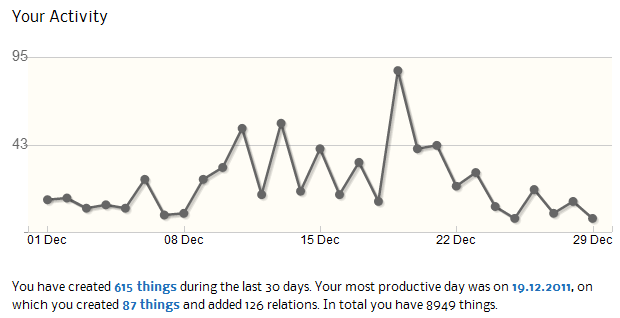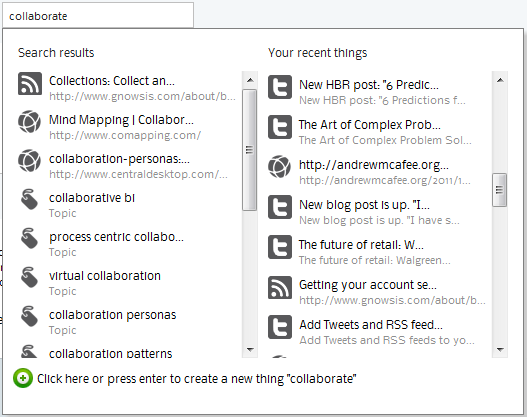Content curation strategies in Refinder: Relating
 Franz Jachim on Fri, 12/30/2011 - 12:50
Franz Jachim on Fri, 12/30/2011 - 12:50 Probably I´m a bit of an information junkie. At least it might appear so, as my Refinder account activity, which I check occasionally from the Dashboard page, exhibits a conglomerate of 8.949 Things, which I have aggregated in Refinder since I subscribed a year ago. And as Refinder turns more and more into a cross-platform tool, which adds integration and collaboration capabilities with connected business apps and online services, the volume of Things piling up in my account is rapidly growing.

Is such a flood of information manageable? I´m convinced it is, provided that we get used to apply tools and methods to our information crunching habits, which are efficient in selecting, collecting, describing, organizing content and render viable guidance while differentiating between relevant and irrelevant stuff.
This is what I believe the term "content curation" stands for.
I´m dedicating this and the next few blog posts to matters of content curation:
In this post, I am talking about relating Things, one of the fundamental techniques and prerequisite to the mastering of large content inventories.
Creating relations
Refinder enables me to capture content from arbitrary webpages or or email conversations with a very few clicks.
For manually added content, like web clippings, I´m striving to not only capture the data, but always furnish it with relations.
Creating relations in Refinder resembles the act of tagging something (as you eventually are used to do with your photos in Flickr). Tags are nothing more than keyword used to describe a piece of data. Refinder goes a bit beyond keywording. Of course you can create tags in Refinder and tie them to your recently acquired content. In Refinder, such tags are Things named "topics", and you are free to create as many as you need.
Over and above, Refinder offers you to tag any type of content with any type of Things. Relating in Refinder means to e.g. associate bookmarks to persons, notes to events, files to notes and so on. You are free to establish unlimited number of relating connections between all Things in your account. In fact, while relating, you create links between the - now - connected Things. Turns out, that the "Note", that you relate to a "Person" causes this "Person" to be linked to the "Note"as well. Seems trivial, but is more effective than connecting pieces of information through shared keywords.
There is a powerful tool in Refinder to apply these relations, and you can find it through an unobtrusive interface element labelled "Search to relate":

Start entering some text into the form. As you type, Refinder presents you a pop-up, displaying two columns of items:

The left column, titled "Search results", comes up with a list of results matching the entered term.
The right column, titled "Your recent things" unveils the list of Things, which you created or edited immediately afore.
Move the mouse over either of these lists and select a list item: a little green icon with a "+" sign appears, which, when clicked, adds a relation between the selected item and the Thing.

In case of no matching items, press enter to let Refinder turn the search-term into a new Thing of type "topic", adding to your existing Things and of course related to your content.
Augment your content with as many relations as you like.
How about auto-relating things?
Of course it is reasonable to demand Refinder to automatically relate Things, based on its text-analytics and machine-learning capabilities. Right now, Refinder does not (yet) auto-relate Things. Instead, and for the time being, relating is a user task, which Refinder strongly supports by making smart suggestions through its "search to relate" functionality.
In a few situations you can save yourself from the exercise of relating. This is the case, when Refinder imports information, that is already equipped with keywords. Think of Tweets, which come along with hashtags or tagged bookmarks imported from Delicious. Refinder understands to turn such imported keywords/tags/hashtags into Things of type "topic" plus saves the relation between the imported piece of information and the topic.
Using relations
The power of these relations unfolds in the content discovery process.
Whenever you search or browse through your Things and Refinder displays a Thing detail, it brings up all of the previously established relations. Find them positioned under the "Search to relate" box. Follow the links, they will guide you through your network of purposefully interconnected, exclusively linked information. Add further relations at any time to enhance this network.
Relations and shared information
What happens with relations, if you share a Thing in a collection?
Relations are primarily strictly personal attributes of your information. This means, that others, whom you gained access to a Thing through sharing, cannot benefit from your relations: they will not see these relations, unless you share the related Things in the same collection.
Check out our whitepaper
"Semantic Technologies Tap Unrealized Potentials of Social Business Platforms".
Tags:

